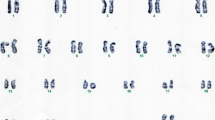Summary
Analysis of 207 case reports on patients with ring autosome showed that: (1) Forty patients, a fifth of the total, had extreme growth failure together with an otherwise almost-normal appearance, viz. no major malformation, no specific deletion syndrome, no or only a few unspecific minor anomalies. This phenotype may be regarded as the “ring syndrome”, a term proposed by Cote et al. (1981) since it is independent of what chromosome is involved. (2) Severe growth failure, the sole major physical abnormality in the “ring syndrome”, was seen significantly more often among patients with ring of larger chromosomes than among patients with a smaller ring, indicating that the greater the chromosome involved in ring formation, the higher is the probability of severe growth failure. (3) Larger ring chromosomes showed significantly more often instability than smaller rings, suggesting that there may be a correlation between ring instability and the size of the chromosome involved. (4) Growth failure was present in significantly more patients with a “labile” ring than with a “stable” ring, indicating that a correlation may exist between ring instability and growth failure. It is suggested that the “ring syndrome” observed in many cases with ring autosome may result from end-to-end fusion of chromosome ends, an event not involving deletion in the genetic sense. It is also suggested that the “ring syndrome” is caused by a continuous generation of secondary aneuploid cells with increased mortality, i.e. structural ring instability which seems to be a function of the size of the chromosome involved. Thus, formation of a ring chromosome in certain cases might be regarded as a “structural mutation”, i.e. an alteration in the structure of the genetic material per se, rather than a loss or gain of genetic dosages.
Similar content being viewed by others
References
Bersu ET (1980) Anatomical analysis of the developmental effects of aneuploidy in man: the Down syndrome. Am J Med Genet 5:399–420
Carrano AV, Heddle JA (1973) The fate of chromosome aberrations. J Theor Biol 38:289–304
Cavalier-Smith T (1974) Palindromic base sequences and replication of eukaryote chromosome ends. Nature 250:457–470
Cote GB, Katsantoni A, Deligeorgis D (1981) The cytogenetic and clinical implication of a ring chromosome 2. Ann Génét (Paris) 24:231–235
DeLozier-Blanchet CD, Guenin R (1984) Cytogenetics of ring chromosome 7. Clin Genet 25:84–85
Dutrillaux B, Aurias A, Couturier J, Croquette MF, Viegas-Pequignot E (1977) Multiple telomeric fusions and chain configurations in human somatic chromosomes. Chromosomes Today 6:37–44
Hoo JJ, Obermann U, Cramer H (1974) The behaviour of ring chromosome 13. Hum Genet 24:161–171
Jansen M, Beemer FA, van der Heiden C, Van Hemel JO, Van den Brande JL (1982) Ring chromosome 2: clinical, chromosomal, and biochemical aspects. Hum Genet 60: 91–95
Kistenmacher ML, Punnett HH (1970) Comparative behaviour of ring chromosomes. Am J Hum Genet 22:304–318
Kjessler B, Gustavson KH, Wigertz A (1978) Apparently non-deleted ring-1 chromosome and extreme growth failure in a mentally retarded girl. Clin Genet 14:8–15
Kosztolányi G (1985) Ring chromosome 4: Wolf syndrome and unspecific developmental anomalies. Acta Paediatr Hung 26:157–165
Kosztolányi G, Pap M (1986) Severe growth failure associated with atrophic intestinal mucosa and ring chromosome 15. Acta Paediatr Scand 75:326–331
Ledbetter DH, Riccardi VM, Au WW, Wilson DP, Holmquist GP (1980) Ring chromosome 15: phenotype, Ag-NOR analysis, secondary aneuploidy, and associated chromosome instability. Cytogenet Cell Genet 27:111–122
McDermott A, Voyce MA, Romain D (1977) Ring chromosome 4. J Med Genet 14:228–232
Niss R, Passarge E (1975) Derivative chromosomal structures from a ring chromosome. Hum Genet 28:9–23
Rocchi M, Cigui I, Archidiacono N, Pecile V, Porcella G, Filippi G (1984) A young girl with ring(18) mosaicism: cytogenetic studies and PEP A mapping. Clin Genet 26:156–160
Schinzel A (1984) Catalogue of unbalanced chromosome aberrations in man. de Gruyter, Berlin New York
Shapiro BL (1983) Down syndrome — a disruption of homeostasis. Am J Med Genet 14:241–269
Tanner JM (1973) Physical growth and development. In: Forfar JO, Arneil GC (eds) Textbook of paediatrics. Churchill Livingstone, Edinburgh London, pp 224–291
Zuffardi O, Danesino C, Polani L, Pavesi F, Bianchi C, Gargantini L (1980) Ring chromosome 12 and latent centromeres. Cytogenet Cell Genet 28:151–157
Yunis E, Leibovici M, Quintero L (1981) Ring(15) chromosome. Hum Genet 57:207–209
Author information
Authors and Affiliations
Rights and permissions
About this article
Cite this article
Kosztolányi, G. Does “ring syndrome” exist? An analysis of 207 case reports on patients with a ring autosome. Hum Genet 75, 174–179 (1987). https://doi.org/10.1007/BF00591082
Received:
Revised:
Issue Date:
DOI: https://doi.org/10.1007/BF00591082




